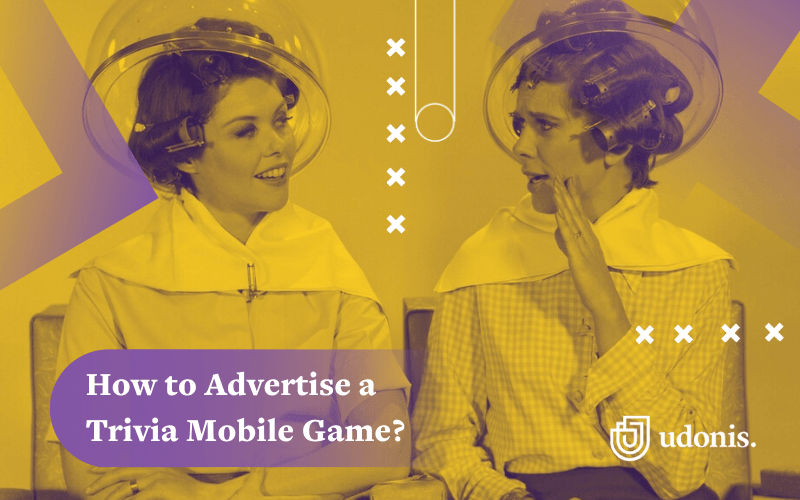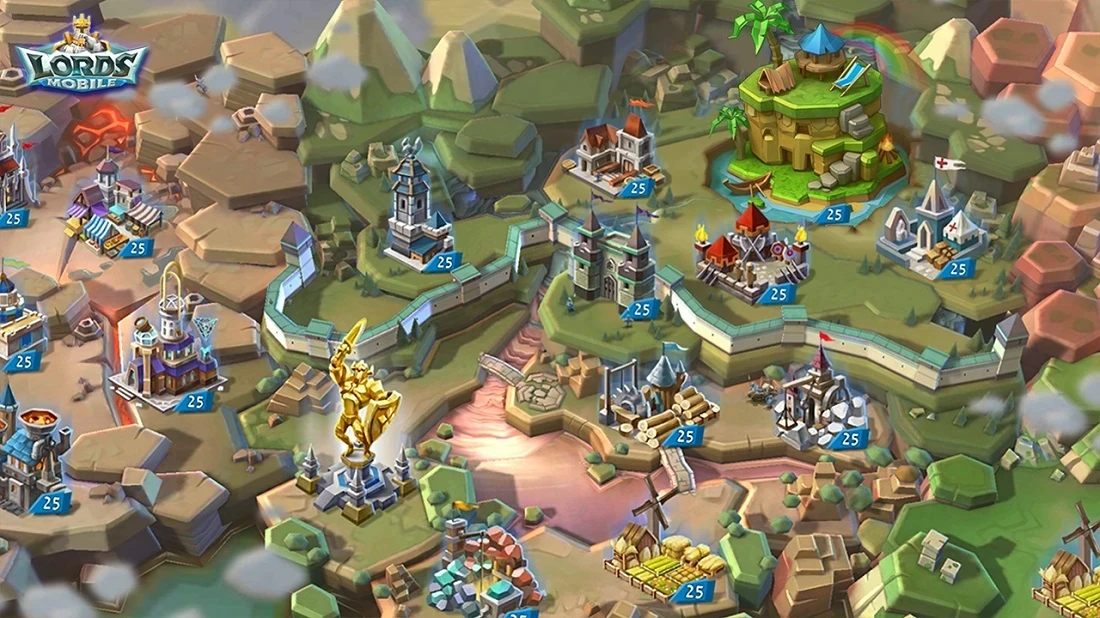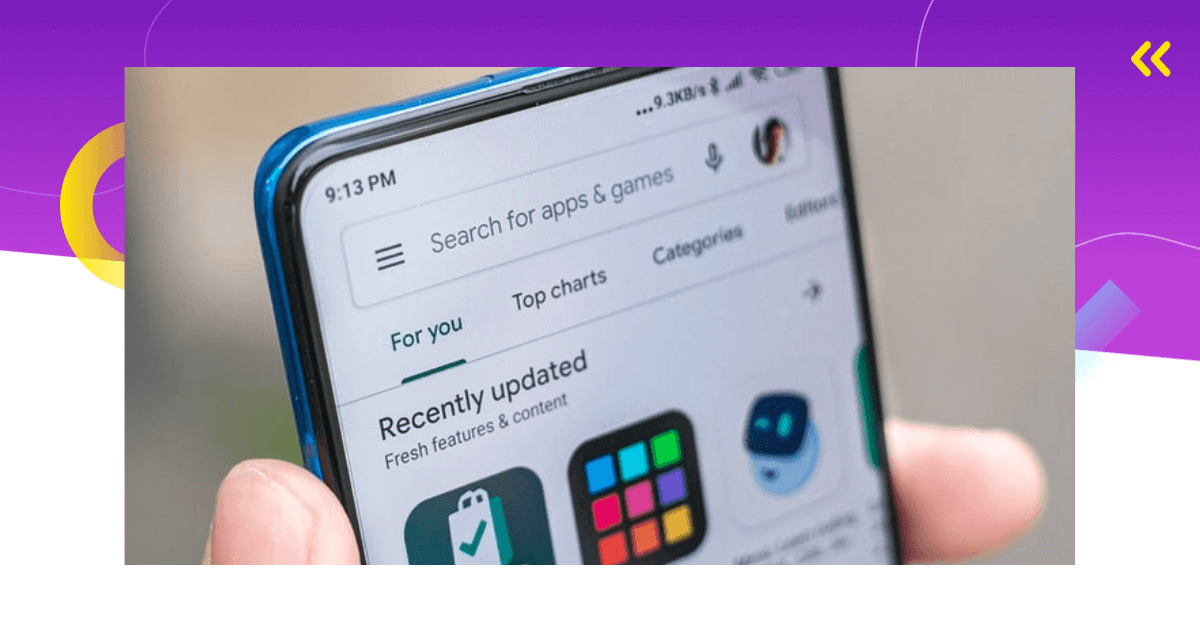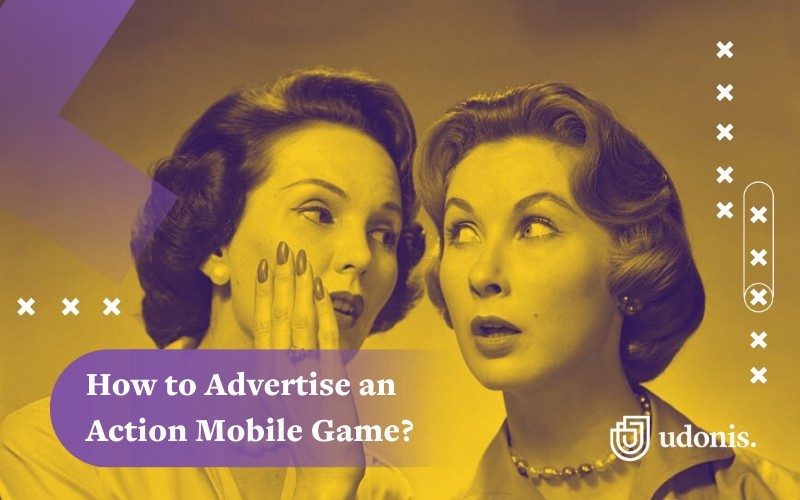Marketing a trivia game can be tricky if you have little or no idea what you’re doing. To develop a mobile game is one thing, but to advertise it and acquire users is a different beast.
But don’t worry, we’re here to help.
In this guide, you’ll learn about:
- The most successful trivia games
- Practical tips for marketing a trivia game
- Video ad examples from top trivia games
- Trivia games statistics
Ready to start acquiring more users?
Top 10 Trivia Games
Google Play
Here’s a list of top-grossing triviagames on Google Play in the US. (SensorTower, free data)
- Trivia Star (Super Lucky Games)
- Trivia Crack No Ads (Etermax)
- Trivia Crack (Etermax)
- Who Wants to Be a Millionaire? (Sony Pictures Television)
- Jeopardy! (Sony Pictures Television)
- Trivia Crack Adventure (Etermax)
- Family Feud (UM Mobile)
- Trivia Crack 2 (Etermax)
- Text or Die (Rollic Games)
- Trivia Puzzle Fortune (Super Lucky Games)
Apple App Store
This is a list of top-grossing trivia games on the Apple App Store in the US. (SensorTower, free data)
- Trivia Crack No Ads (Etermax)
- Trivia Star (Super Lucky Games)
- Trivia Crack (Etermax)
- Jeopardy! (Sony Pictures Television)
- Exposed – Who’s Most Likely To (Vysgames)
- Who Wants to Be a Millionaire? (Sony Pictures Television)
- Song Pop 2 (FreshPlanet)
- Adorable Home (HyperBeard)
- Family Feud (UM Mobile)
- Word Card (Word Puzzle Games)

5 Tips for Marketing a Trivia Game in 2022
Here’s how to acquire more users for a trivia game!
1. Do Thorough Research
Before you start running ads for your trivia game, it’s crucial to plan things out first. Otherwise, you’ll be wasting your time and money on campaigns that won’t bring you the results you expect.
Planning includes doing research on your competitors and target audience as well as setting clear goals for your user acquisition campaign.

Research Your Competitors
Start with spying on your competitors – you’ll learn a lot by looking at what they do. Who is their user base? What user acquisition techniques are they using? What kind of ads are your competitors running and on which ad networks? How do their app store pages look?
That data will help you learn what works for marketing a trivia game and you’ll have a better sense of where to start.
Define Your Target Audience
Next, think about your target audience. The key to acquiring a lot of users is knowing who those users are.
If you already have users who play your trivia game, identifying what they have in common is a great start. However, if your game is brand new, you won’t have that data.
In that case, start with the basics like defining the age and location of your target audience. Then expand it with their interests, preferences, and behaviors.
Identifying the key features and benefits of your trivia game will help you with this process.
What’s the theme of your trivia game? Are the questions in your trivia game easy or hard? Is it for kids or adults? Is it educational? How hard is it to master your trivia game?
Now ask yourself, what type of gamers would be attracted to that kind of game? For example, trivia games tend to attract casual players who play to pass the time, but that depends on the game itself.
Set Clear Goals
The final part of research and preparation is setting clear goals for a user acquisition campaign.
What do you want to achieve?
“I want to acquire more users” is not clear enough.
How many users do you want to acquire in a certain time period? What strategies you’ll use to achieve that goal? What is your budget? Be as specific as possible.

2. Start Running Facebook App Ads
Although there are some methods of acquiring users organically, if you’re serious about your game, you should go the paid ads route.
Here’s the thing.
All successful mobile game studios run ads on multiple ad networks in order to advertise their game and grow their user base. It’s hands down the most effective user acquisition strategy.
One of the best ad networks for increasing mobile game downloads is Facebook.
Facebook App Ads allow you to reach a global audience across Facebook, Instagram, and Audience Network and make it simple for users to download the game. Not only that, but there’s also the option to run ads that encourage players to come back and keep playing.
In other words, there are multiple campaign objectives you can choose from – app installs, traffic, and conversions.

Facebook App Ads Objectives
When App Installs are the objective, the ad encourages the users to download your trivia game. It links directly to Google Play or Apple App Store, which makes it easy and convenient for users to download it.
You can also further optimize App Install Ads for app events. App Event Optimization allows you to optimize mobile game ads so that they’re shown to users who are likely to take a specific action within your game.
For example, you might want users who are likely to make an in-app purchase to install your app. You can do that by choosing “purchases” as the app event.
Other app events you can choose from are achieved level, content view, completed registration, app launched, etc.
If you choose Traffic or Conversion as your ad objective, you can boost the engagement for existing users. The Traffic objective will encourage players to come back. An ad with the Conversions objective will drive specific actions in the game – for example, finish a level.
General Tips for Optimizing Facebook Ad Campaigns
- You don’t need thousands of ad sets – reduce the numbers and make it simple
- Create assets for different placements (images, text, video, HTML5)
- Choose the right objective and events – installs, in-app purchases, etc.
- Use Campaign Budget Optimization
- Choose the right bid strategy
PRO TIP: Even though you don’t need to integrate Facebook’s SDK in order to run ads, it’s a good idea to do so. It allows you to further optimize the ads as well as track installs.

How to Structure a Facebook Ad Campaign?
If you’re new to setting up Facebook Ad Campaigns, you might be confused with the process.
So here’s a simple example of how to structure a Facebook ad campaign.
The first phase is testing the ads.
When setting up the campaign, choose the lowest cost as the bidding strategy and set a $100 daily budget. Then create 3 ad sets for 3 different age groups (13-24, 25-44, 45-65) with 10 video ads for each set.
Run the video ads for three days. Then analyze them and identify the winners from each set, i.e. the ads that have the lowest CPI.
Then you move to the second phase where you choose bid cap as the objective and a daily budget of $1000.
Create 2 ad sets. The first one will target a broad audience (13-65), while the second one will target lookalike audiences (people who watched your video to 50%). Add the winning ads from the previous step into both ad sets.
That’s it!
This simple process can greatly improve the effectiveness of your user acquisition strategy.
However, this is only the beginning. There are advanced Facebook Ad strategies you can use to get even better results.
So if you need help with running Facebook Ad Campaigns for mobile games, feel free to reach out – it’s what we do best!

3. Master Google’s Universal App Campaigns
Along with Facebook, Google is an ad network that’s perfect for acquiring mobile gamers. With its Universal App Campaigns, you can simply upload your assets, and Google will test different variations of the ad. Ads that perform better are shown more often.
Similar to Facebook Ads, there are two different types of campaigns you can optimize your UAC for – app installs and in-app conversions.
When you choose installs, the campaign optimizes toward boosting app installs.
When you choose in-app conversions, the campaign optimizes for the cost of a specific in-app event.
Simple, right?
Optimize Creative Assets for Universal App Campaigns
Another important aspect of Universal App Campaigns is optimizing your creative assets.
There are two ways adding assents for UAC – uploading assets or importing them from the App Store (game title, icon, screenshots, etc.)
Furthermore, there are three types of assets you can upload – text, image, and video assets. Google allows you to upload 4 text ideas, 20 image assets, as well as 20 video assets to each ad group. However, there’s no limit on the number of ad groups.
What’s great about creating multiple ad groups is that each one can have a different theme. For example, you can create an ad group for each game feature or benefit as well as for different audiences.
When it comes to text assets, you need to add four short texts up to 25 characters. Focus on the features and benefits of your trivia game and add relevant keywords. Remember to optimize the text according to the campaign objective (install volume or in-app actions).
The next step is adding image assets. Google recommends using simple designs and screenshots from your trivia game. Consider different image sizes and formats.
The final step is uploading video assets.
An important thing to note is that if you allow Google to upload assets from your app store listing’s page, it will automatically create a video from App Store content. That’s not good because you don’t have any control over that video and the quality will be low.
That’s why you should always upload your own video assets.
Video creatives are crucial for the success of your campaign because this ad format attracts high LTV users.
Why?
Simple – users who have watched a video of your trivia game before installing it will have the best preview of it and thus are more likely to continue playing post-download.
If you want to learn how to create kickass video ads for your trivia game, make sure to stick around. Later in the article, I analyze video ads from top trivia games.

4. Spread Out to Other Ad Networks
Once your Facebook and Google campaigns are up and running, it’s time to add other ad networks in the mix.
Running ads on multiple ad networks makes a user acquisition campaign more effective because it allows you to reach a wider audience.
You’re probably wondering, which ad networks, besides Facebook and Google, are great for acquiring mobile gamers?
According to AppsFlyer Performance Index, the top ad networks in the gaming category are:
- Google Ads
- Applovin
- Unity Ads
- ironSource
- Apple Search Ads
- Mintegral
- Vungle
- Snapchat
- TikTok Ads
You might be surprised to find TikTok on this list, considering this is a very young platform. However, TikTok has experienced rapid growth in 2020, especially during the coronavirus outbreak.
TikTok has reached more than 2 billion users in May 2020. That means there are many opportunities for advertising. With TikTok Ads, you can reach a large global audience that’s ready to play your trivia game.

5. Get Advanced with App Store Optimization
You probably already know the basics of app store optimization. It’s a good way to get more users organically. However, choosing a good game title, writing a compelling description, adding relevant keywords, and screenshots is only the beginning.
In order to get the most out of ASO, you need to do some testing.
Increase Conversions by A/B Testing ASO Components
No matter how well you research your competitors, keywords, trends, etc., it’s still very hard to get ASO right without testing.
Doing A/B tests is the only way to know for sure whether your app store page is done right and drives conversions.
While you should test all ASO components (game title, game icon, keywords, descriptions, screenshots), I advise you to focus on getting your app store videos right.
As it was mentioned before, videos are crucial for getting high-value users. Images and words simply can’t capture the essence of your trivia game as well as videos.
Video Ad Examples from Top Trivia Games
To show you how it’s done, I have analyzed video ads from the most successful trivia games.
Who Wants to Be a Millionaire? (Sony Pictures Television)
Video ad duration: 00:15
Platforms: Facebook, Instagram, Messenger, Audience Network
Ad Copy: 🏠Stuck at home? Don’t turn into a couch potato! Play and Learn 🥔
Based on the hit TV game show, Who Wants to Be a Millionaire is a highly successful trivia game with millions of users.
While it’s easier to acquire users for a trivia game that’s based on a popular show/brand, it’s still crucial to run video ads.
As you can see above, this video ad is simple and straightforward. There are no flashy visuals, animations, or effects.
That makes sense considering people don’t play trivia games for the top-notch graphics or out of this world characters. Trivia games are about the questions and the fun behind testing your knowledge and learning new things.
So when creating a video ad for a trivia game, make sure to explain the theme of the game. Is it a logo trivia game, a general knowledge quiz?
In this case, the question is about who is the greatest basketball player of all time. This is a clever question to put in the ad for several reasons. First of all, this is a highly debated question. There’s no clear objective answer – it’s based more on personal opinions. But that’s good because it grabs the attention of the users.
Secondly, The Last Dance (a documentary about Michael Jordan) is currently one of the most-watched shows on Netflix. That means everybody is talking about it.
What you can learn from this is to feature questions that are topical and drive interest.
Furthermore, when creating a video ad, highlight the main game features as well as the objective – what’s the reward for getting the questions right?
Finally, make sure to write a compelling ad copy. Who Wants to Be a Millionaire ad copy is quite clever because it refers to the quarantine most of the world is still going through. (🏠Stuck at home? Don’t turn into a couch potato! Play and Learn 🥔)
Jeopardy!® World Tour (Sony Pictures Television)
Video ad duration: 00:14
Platforms: Facebook, Instagram, Messenger, Audience Network
Ad Copy: Play the world-famous trivia game today!
To show you that it can be tricky to advertise on Facebook and create a good ad, here’s an example of an ad from Jeopardy World Tour that has been disapproved.
This will be a lesson in what not to do when marketing a trivia game.

As you can see in the screenshot above, this ad is inactive because it ran without a disclaimer.
Now, you might wonder what the hell does that mean?
Well, since Facebook is one of the biggest social media networks ever, it attracts a lot of advertisers. However, those advertisers are not just different businesses and brands, but politicians as well.
As you might have noticed, it has become common practice for politicians and presidential candidates to advertise on Facebook and grow their campaigns. Since that can become quite shady and manipulative, Facebook requires ads about social issues, elections, or politics to have a disclaimer in order to increase transparency.
In other words, these ads have to go through an authorization process.

“These ads must have a disclaimer with the name and entity that paid for the ads. If an ad runs without a disclaimer, it’ll be paused, disapproved, and added to the Ad Library, until the advertiser completes the authorization process.” – Facebook
This brings us back to the flagged Jeopardy World Tour ad.
Since the Jeopardy question in the ad is about Trump, Facebook saw that as an ad “About Social Issues, Elections or Politics”. Since it wasn’t authorized and didn’t have a disclaimer, it was disapproved.
Now, you might say the Jeopardy ad is not really a political ad, but let’s not get into that.
The lesson here is to be very careful when creating video ads. You need to make sure you follow all of the rules and guidelines of the ad network you’re advertising on.
Otherwise, you’ll waste time and money on ads that will be disapproved – or even worse – your ad account might be disabled.
Trivia Game Statistics You Need to Know in 2022
The final piece of the puzzle is mobile game metrics. Every developer should track metrics like user retention, average session length, stickiness, ARPPU, and ARPDAU.
Those help you optimize towards better performance. Tracking game metrics is what separates newbie developers from successful game companies.
To help you benchmark your mobile game, I have put together the most important trivia game statistics. All the data is fresh and comes from GameAnalytics.
Let’s start with user retention – a crucial metric for mobile game developers.
Trivia Game User Retention Statistics
As you might, user retention is one of the most important KPIs every developer should track. It tells you how many users keep playing your trivia game after a certain time period (usually, it’s measured after days 1, 7, and 28).
Of course, the goal is to have high user retention. However, remember that this metric can and should be improved constantly.

Day 1 User Retention Statistics for Trivia Games
Wondering whether your trivia game has potential? Day 1 user retention is a KPI that will reveal that to you.
When a game has very low user retention after day 1, it means it either needs to be completely redeveloped or scrapped. In fact, it is common practice for many game studios to kill games that retain less than 30% of users after the first day.
Player retention after day 1 is especially important for trivia games, since they fall into the group of best performing genres according to this KPI.
For the top 2% of trivia games it was at its highest point in February when it hit 55.02%, while the lowest point was in August at 45.93%.
The top 25% had steadier retention rates, ranging from 33.81% in March to 30.65% in September.
The median 50% of trivia games had day 1 retention in the range from 26.84% in May to 22.91% in September.
Finally, the bottom 25% of trivia games moved between 17.93% in May to 14.70% in September.

Day 7 User Retention Statistics for Trivia Games
Next up, day 7 user retention – how many players come back after a week?
As you might expect, less than after one day.
When it comes to retaining players after 7 days, the top 2% of trivia games fluctuated a bit over the year. The peak was in March when retention rate hit 27.60%, and the lowest point happened in May when it was at 20.58%.
In the top quarter of trivia games, the numbers were higher at the beginning of the year, when day 7 retention peaked to 12.24% in January. It was the lowest in November, at 8.91%.
The average performing games had only minor fluctuations, going from 6.04% in January to 4.71% in August.
When it comes to the bottom half, the numbers ranged from 2.78% in March to 1.89% in April, with constant ups and downs over the year.

Day 28 User Retention Statistics for Trivia Games
Retaining users after one month is not an easy feat considering the competition is high and players tend to get bored easily. However, if you work on making your game more engaging and addictive, it’s possible to have high day 28 retention.
The top 2% of trivia games were able to retain as much as 20.09% of players after 28 days’ time at the beginning of April. Interestingly, the second half of April is when they hit the lowest mark – 11.93%. Overall, there were plenty of fluctuations during the year.
The top 25% of trivia games started the year well with a retention rate of 5.07%. In September and August, it was at its lowest point, at 3.20%.
The median 50% of games varied slightly over the year, averaging at 1.29%.
The games that fall into the bottom 25% category moved between 0% and 0.32%
Tips for Improving User Retention
Here are some tips for improving user retention from Shayan Fatani, a Digital Marketing Strategist who specializes in consumer behavior.
- Incentive: Give your users an incentive to stay with you besides the game itself. This could be weekly events (Fornite Concert), or added features (League of Legends- One For All). Now you must be thinking, those are PC games, but remember, there are no limitations.
- Engagement: If you want the user to open the app at least once, you need to give them a reason to, it’s simple. A user will only open the app if there is some personal gain, be it an ego-boost like. So you can introduce daily tasks or goals in return for a skin, coins etc.
- Social Interaction: If your game is connected to the social networks this would increase engagement. Be it negative or positive (opposing opinions is what builds the conversation), your mentions would increase the awareness and build an attachment to the game.
- Push Notifications: This is the most common type of user retention technique used in the application industry where the user is constantly reminded of the app with something intriguing that would get a click or at least, get their attention.

Average Session Length Statistics for Trivia Games
Average session length is another important mobile game metric you should track. This KPI tells you how long users play your game – it is measured from the moment the app is opened until it’s closed.
Just like other casual games, trivia games are not characterized by long sessions.
The top 2% of trivia games had sessions from 25 to 16 minutes. The numbers fluctuated throughout the year, the lowest values having been in the period between October and December.
In the case of the top 25% of games, sessions were in a range from 6 to 7 minutes.
The median 50% of games were steady at 4 minutes, while the bottom 25% of games had sessions of approximately 2-3 minutes.

ARPPU Statistics for Trivia Games
The goal of every developer is to successfully monetize their game. Naturally, knowing how much users spend on games is crucial.
The average revenue per paying user, or ARPPU, is a KPI that tells developers exactly that.
ARPPU tells us how much money a paying user leaves in a game over a certain time period.
When it comes to the top 2% of trivia games, ARPPU fluctuated significantly throughout the whole of 2020. At one point in May, it reached $78.77, and had serious drops throughout the year, with the lowest point in February at $28.11.
In the top 25% of games, the fluctuations were smaller, from $9.59 in July to $6.19 in March.
In the median 50% of games, ARPPU values were between $5.86 in August and $3.35 in March.
The bottom 25% of games moved in the range from $2.82 in November to $1.63 in February.

ARPDAU Statistics for Trivia Games
Average revenue per daily active user, also known as ARPDAU, tells you how much money you make from a user in one day.
Good in-game offers are the key to increasing ARPDAU – you need to understand how much users are willing to pay and how valuable are the in-game purchases.
ARPDAU gives us an average revenue generated by your average user, including both paying and non-paying users.
When it comes to average revenue per daily active user, it also varied the most in the top 2% category. It peaked in March at $0.26, while it was as low as $0.06 in November.
When it comes to the top 25% of trivia games, ARPDAU was between $0.01 and $0.03.
The median 50% of games stayed at $0.01 throughout the year.
There was no data available for the bottom 25% of trivia games.

Conversion Statistics for Trivia Games
Conversion data is the percentage of users who made a purchase that day. It is analyzed daily.
Finally, let’s go over the percentage of users that made in-app purchases in trivia games.
The top 2% of trivia games had month-over-month fluctuations, with a peak in April at 1.67%. Conversion rate was lowest in November, at 0.70%.
The top 25% of games ranged from 0.49% in May and June to 0.31% in November.
Conversion rates for the median 50% of games were between 0.15% in June and 0.27% in December.
Finally, conversions for the bottom 25% of games ranged between 0.13% and 0.06%.
Final Thoughts on Marketing a Trivia Game
Now we want to hear from you!
What is the most challenging part of marketing a trivia game? Do you need help with anything?
Feel free to reach out – we’re here to help!







Comments